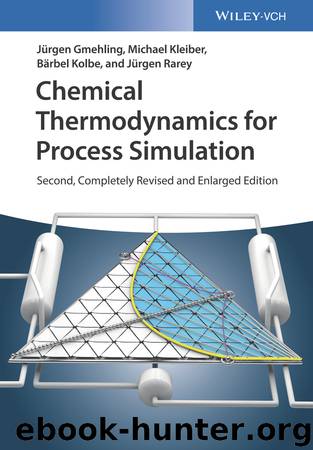Chemical Thermodynamics for Process Simulation by Gmehling Jurgen;Kleiber Michael;Kolbe Barbel;Rarey Jurgen;

Author:Gmehling, Jurgen;Kleiber, Michael;Kolbe, Barbel;Rarey, Jurgen;
Language: eng
Format: epub
ISBN: 9783527809448
Publisher: John Wiley & Sons, Inc.
Published: 2019-03-28T17:32:31+00:00
7.3 Activity Coefficient Models for Electrolyte Solutions
7.3.1 Debye–Hückel Limiting Law
For the development of activity coefficient models for electrolyte solutions, the theory of Debye and Hückel is usually the starting point. It can be regarded as an exact equation to describe the behavior of an electrolyte system at infinite dilution.
For the derivation of the Debye–Hückel limiting law, the following assumptions are made [2] :
(1) Only the electrostatic forces between the ions are regarded. All the other forces are negligible.
(2) The electrostatic interaction energies are small in comparison with the thermal energies.
(3) The ions are regarded as punctual charges with a spherical field.
(4) The dielectric constant of the solution is equal to the one of the solvent.
(5) The electrolyte is completely dissociated.
(6) The distribution of the ions around a center ion is governed by Boltzmann's law due to the electric potential: 7.46
where ci(r) is the volume concentration of ionic species in a volume element at distance r from the center, is the same property when all the ions are uniformly distributed, and ϕel(r) is the electric potential at distance r from the center.
Download
This site does not store any files on its server. We only index and link to content provided by other sites. Please contact the content providers to delete copyright contents if any and email us, we'll remove relevant links or contents immediately.
| Fluid Dynamics | Thermodynamics |
The Complete Stick Figure Physics Tutorials by Allen Sarah(7137)
Secrets of Antigravity Propulsion: Tesla, UFOs, and Classified Aerospace Technology by Ph.D. Paul A. Laviolette(4989)
Thing Explainer by Randall Munroe(3782)
The River of Consciousness by Oliver Sacks(3417)
The Order of Time by Carlo Rovelli(3073)
How To by Randall Munroe(2913)
I Live in the Future & Here's How It Works by Nick Bilton(2844)
A Brief History of Time by Stephen Hawking(2819)
What If?: Serious Scientific Answers to Absurd Hypothetical Questions by Randall Munroe(2543)
The Great Unknown by Marcus du Sautoy(2536)
Midnight in Chernobyl by Adam Higginbotham(2388)
Blockchain: Ultimate Step By Step Guide To Understanding Blockchain Technology, Bitcoin Creation, and the future of Money (Novice to Expert) by Keizer Söze(2379)
Networks: An Introduction by Newman Mark(2264)
The Meaning of it All by Richard Feynman(2213)
Easy Electronics by Charles Platt(2207)
The Tao of Physics by Fritjof Capra(2166)
Midnight in Chernobyl: The Untold Story of the World's Greatest Nuclear Disaster by Adam Higginbotham(2077)
When by Daniel H Pink(2021)
Introducing Relativity by Bruce Bassett(2018)
